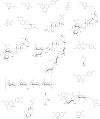Proposed mechanisms of action of herbal drugs and their biologically active constituents in the treatment of coughs: an overview
- PMID: 37901462
- PMCID: PMC10607228
- DOI: 10.7717/peerj.16096
Proposed mechanisms of action of herbal drugs and their biologically active constituents in the treatment of coughs: an overview
Abstract
Various medicinal plants find their use in cough treatment, based on traditions and long-term experience. Pharmacological principles of their action, however, are much less known. Herbal drugs usually contain a mixture of potentially active compounds, which can manifest diverse effects. Expectorant or antitussive effects, which can be accompanied by others, such as anti-inflammatory or antibacterial, are probably the most important in the treatment of coughs. The aim of this review is to summarize the current state of knowledge of the effects of medicinal plants or their constituents on cough, based on reliable pharmacological studies. First, a comprehensive description of each effect is provided in order to explain the possible mechanism of action in detail. Next, the results related to individual plants and substances are summarized and critically discussed based on pharmacological in vivo and in vitro investigation.
Keywords: Anti-inflammatory; Antibacterial; Antitussive; Antiviral; Cough; Expectorant; Herbal drugs; Mechanism of action; Medicinal plants; Phytotherapy.
© 2023 Pourova et al.
Conflict of interest statement
The authors declare that they have no competing interests.
Figures

Similar articles
-
Expectorant and antitussive effect of Hedera helix and Rhizoma coptidis extracts mixture.Yonsei Med J. 2015 May;56(3):819-24. doi: 10.3349/ymj.2015.56.3.819. Yonsei Med J. 2015. PMID: 25837191 Free PMC article.
-
Antitussive, expectorant, and anti-inflammatory activities of four caffeoylquinic acids isolated from Tussilago farfara.Pharm Biol. 2016 Jul;54(7):1117-24. doi: 10.3109/13880209.2015.1075048. Epub 2015 Oct 6. Pharm Biol. 2016. PMID: 26439905
-
Comparative Antitussive Effects of Medicinal Plants and Their Constituents.Altern Ther Health Med. 2018 Jul;24(4):36-49. Altern Ther Health Med. 2018. PMID: 29332022 Review.
-
NMR based metabolomic comparison of the antitussive and expectorant effect of Farfarae Flos collected at different stages.J Pharm Biomed Anal. 2018 Feb 20;150:377-385. doi: 10.1016/j.jpba.2017.12.028. Epub 2017 Dec 13. J Pharm Biomed Anal. 2018. PMID: 29287265
-
An Evidence-Based Review of Antitussive Herbs Containing Essential Oils in Traditional Persian Medicine.Curr Drug Discov Technol. 2021;18(2):179-185. doi: 10.2174/1568009620666200421091245. Curr Drug Discov Technol. 2021. PMID: 32316897 Review.
Cited by
-
Therapeutic Potential of a Natural Blend of Aronia melancarpa, Lonicera caerulea, and Echinacea purpurea Extracts in Treating Upper Respiratory Tract Infections: Preliminary Clinical and In Vitro Immunomodulatory Insights.Int J Mol Sci. 2024 Dec 15;25(24):13436. doi: 10.3390/ijms252413436. Int J Mol Sci. 2024. PMID: 39769201 Free PMC article. Clinical Trial.
References
-
- Afzali H, Kashanian M, Akbari H. Comparison of the effects of Tussivin (Z. multiflora and Foeniculum vulgare essential oils) in treatment of cough. Kashan: Barij Essence Pharmaceutical Company; 1998. pp. 35–40.
-
- Akhtar M, Shaukat A, Zahoor A, Chen Y, Wang Y, Yang M, Umar T, Guo M, Deng G. Anti-inflammatory effects of Hederacoside-C on Staphylococcus aureus induced inflammation via TLRs and their downstream signal pathway in vivo and in vitro. Microbial Pathogenesis. 2019;137(11):103767. doi: 10.1016/j.micpath.2019.103767. - DOI - PubMed
Publication types
MeSH terms
Substances
LinkOut - more resources
Full Text Sources
Medical

